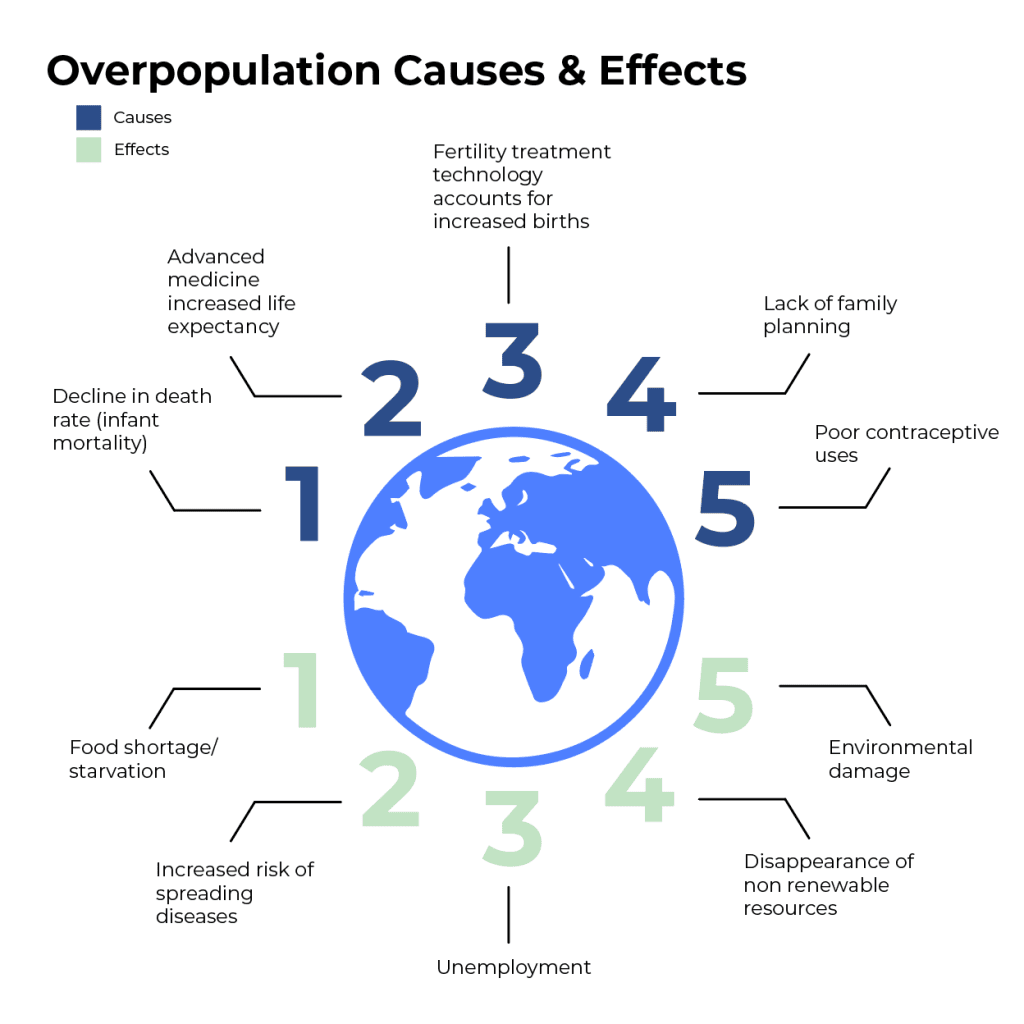Sustainable Solutions to Population Growth: Balancing Act For a Greener Future
Imagine a city where every square inch is occupied, resources are scarce, and pollution is rampant. That’s the reality for many places as the world’s population exceeds 8 billion.
In this piece, we’ll explore the implications of this explosive growth and discover how we can create a balanced, sustainable future.
We’ll also talk about the role of education, healthcare, development aid, and advocacy and policy efforts in managing population growth and encouraging sustainable practices.
Chapters
Understanding Global Population Growth

Global population growth is a crucial factor impacting our planet’s resources and sustainability. The population growth rates differ across countries. Rapidly developing regions like Africa are growing much faster than Europe. By 2050, over half of the global population will be city dwellers.
But population growth is more than just numbers; it’s about the strain those numbers put on food, water, and energy supplies. It’s about the increased waste and pollution we produce, and its effect on our climate and biodiversity.
Managing such growth is a delicate balance of ensuring everyone’s needs are met without depleting our planet’s resources.
The Impact of Population Growth
Population growth can strain our resources, degrade the environment, and trigger social challenges. On the upside, it can spur economic development, foster innovation, and enhance cultural diversity. Balancing these dual impacts is crucial for a sustainable future.
Here are some key impacts:
- Economic advancement: More people can mean more innovation and economic growth.
- Environmental strain: Increased consumption can lead to resource depletion and pollution.
- Social challenges: Rapid urbanization and healthcare demands can overwhelm infrastructures.
- Cultural benefits: A growing population can enrich our world through increased diversity and exchange of ideas.
Consequences of Rapid Population Expansion
Is the world overpopulated? How does rapid population expansion impact our world, and more importantly, our future? It’s a pressing concern that affects every facet of our lives, from the economy to the environment.
- Resource Depletion: Increased population leads to overuse of natural resources, causing scarcity.
- Environmental Degradation: As discussed previously, more people mean more waste, pollution, and, ultimately, climate change.
- Socioeconomic Issues: Rapid growth can exacerbate poverty, inequality, and social unrest.

Resource Demand and Population Expansion
As our population continues to grow, you’ll notice a significant increase in the demand for resources, posing a major challenge to building a sustainable future.
More people means more consumption, from food and water to energy and raw materials. As we consume, we also create waste, straining our planet’s ability to regenerate.
It’s a tough balancing act, ensuring everyone’s needs are met without depleting our resources. It’s not just about quantity, it’s also about quality. We need to make sure the resources we use are sustainable, renewable, and don’t harm our environment.
It’s a complex issue, but one we can’t afford to ignore. We all have a part to play in finding solutions, through mindful consumption, innovative technologies, and responsible policies.
Healthcare Challenges in Growing Populations
As population numbers rise, the demand for healthcare inevitably follows suit. This can lead to overcrowded and understaffed medical facilities, making it harder to provide quality care. Additionally, increased strain on public health systems can potentially lead to compromised healthcare.
The exacerbation of health inequities is also a significant concern, with disadvantaged communities suffering the most. Lastly, there is a higher risk of disease outbreaks due to overcrowding and inadequate healthcare.
Overcoming Societal and Cultural Resistance to Sustainable Solutions
Traditional beliefs and lack of education are often the biggest hurdles when trying to implement sustainable solutions to population growth. To address these, we need to:
- Foster dialogue and respect cultural diversity while educating about the importance of sustainable practices.
- Address gender inequality; empower women through education and healthcare, as they play a vital role in family planning decisions.
- Combat stigma surrounding family planning with comprehensive educational campaigns.
- Advocate for political will and resource allocation for population management.
- Engage communities, build trust, and address their specific concerns.
Empowering Through Education
Education, especially about sex and reproductive health, can give citizens the tools to control the fertility rate, reducing population pressure on resources. It’s also crucial in promoting responsible decision-making about family planning.
Furthermore, understanding population dynamics in the context of resource utilization and environmental sustainability can help you grasp the interconnectedness of these issues. Education doesn’t just mold informed citizens; it creates environmentally conscious stewards of the future.
The Significance of Healthcare Access
While gaining knowledge through education is essential, having access to healthcare, particularly reproductive health services, is equally crucial in managing population growth and promoting sustainability.
Access to healthcare provides numerous benefits:
- It allows individuals to control their fertility, contributing to a decline in population growth.
- It can increase life expectancy and enhance quality of life, promoting a healthier population.
- Access to healthcare empowers women, who often bear the brunt of population growth, to make informed decisions about family planning.
The Role of Development Aid

We can’t overlook the significant role that development aid plays in managing population growth. This financial support to developing countries aids in infrastructure development, promotes economic growth, and reduces poverty. It also enhances access to education and healthcare, fostering sustainable development.
But it’s not all smooth sailing. Challenges like limited funding, corruption, and mismanagement can hamper the effectiveness of aid. Despite these challenges, when used rightly, development aid can improve living conditions, increase access to clean water and sanitation, and reduce inequality.
Therefore, people must recognize its importance and advocate for transparency and accountability in its distribution. In the end, development aid can be a game-changer in creating a greener future.
Balancing Population Growth With Advocacy and Policy Efforts
To make a significant impact on sustainable population growth, we need to focus on two key areas: strong advocacy and the development of effective policies.
Advocacy involves raising awareness, influencing decision-makers, and mobilizing resources towards a sustainable cause. On the other hand, policy efforts aim at establishing frameworks that guide actions towards sustainable growth.
Here are four ways you, as a citizen, can contribute:
- Promote public awareness about the impacts of population growth on our environment.
- Advocate for policies that prioritize sustainable development and population control.
- Encourage governmental and non-governmental organizations to invest in green initiatives.
- Foster collaborations with stakeholders for effective policy implementation.
With concerted efforts, we can strike a balance between population growth and environmental sustainability.
Improve your Marketing with the Power of AI
See how you can start with AI Marketing and reach your goals faster than ever before. Check out the Tips, Strategies, AI Tools, Masterclass, Courses, and Community. Unleash the true potential of your brand with the help of AI.